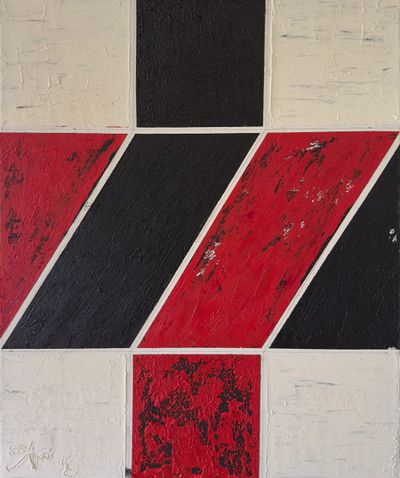Casus Belli
Tibor Babos
War Collection
Paradox Constructivism / Constructive Unrealism
2024
60 x 50 cm (23.6 x 19.6 in)
Oil on 3D+ Canvas
Budapest
In Private Collection
Casus Belli (2024) by Tibor Babos is not a painting of war — it is war, coded into geometry. With this piece, the artist confronts the viewer with the architecture of conflict: its premeditation, its choreography, and its moral absurdity. Stripped of spectacle, stripped of narrative, the work presents violence as a system. Aestheticized not to distance, but to reveal.
The composition is stark, divided with almost militaristic precision. Rectangles and slanted parallelograms interlock across the canvas like compartments in a tactical map or the cells of a war room schematic. Each form is confined, each plane isolated by sharp white borders. There is no chaos here — only calculation. The aggression is not emotional but structural. Babos’s grid becomes a metaphor for how ideology is segmented, weaponized, and deployed. The painting operates as a machine, impassive in its violence, dispassionate in its design.
Diagonal thrusts dominate the center of the canvas — harsh, black-red parallelograms flanking a central rupture. These are not gentle compositional elements; they cut. They mimic the incursion of force, of territory breached, of weapons crossing lines. The entire canvas feels like a warning system — a visual siren. The forms do not rest. They press forward. The very geometry suggests forward momentum, a logic of escalation.
But Babos’s restraint is what lends the work its power. No explosions. No figures. Just three colors: red, black, and white. Each is deliberately corrupted. The black is thick, suffocating — a visual analog to industrial machinery, to armored steel, to the opacity of military command. The red is wounded, scraped, violently alive — the surface flayed with pigment, echoing blood, propaganda, panic. And the white — perhaps the most damning — is no longer clean. It is marred, smeared, bruised. This is not the white of peace or surrender. This is the white of plausible deniability. The white of silence.
Surface matters here more than ever. The 3D+ canvas creates depth without illusion. Each panel feels like a slab. A wall. A command. The texture of the oil is physical, nearly geological — dragged, carved, pitted. These marks read as scars: bureaucratic decisions rendered in pigment. The work feels constructed and wounded at once, as if the act of painting it replicated the psychological mechanics of war itself — repetitive, procedural, dehumanized.
Babos’s own background — military strategist turned artist — casts a long shadow across Casus Belli. He does not approach the theme from outside. He has studied its systems, internalized its logic, and now re-engineers it into visual critique. This is not protest art. It is diagnostic. It shows how war is made: how it is framed, rationalized, sold. The painting’s title — Casus Belli, the justification for conflict — is rendered here not as text, but as a modular schema. It reminds us that wars begin not with gunfire, but with justification. With diagrams. With abstractions.
And that is perhaps the most haunting aspect of the work. It implicates abstraction itself. These forms, so clean, so organized, are not innocent. They become accomplices. The painting resists the easy binary of figuration versus non-figuration. Babos reveals that abstraction, like policy, like rhetoric, can be mobilized for destruction. The canvas is no longer a space of contemplation. It is a site of complicity.
Casus Belli is unflinching. It does not offer catharsis. It does not mourn. It observes, indicts, and remains. The viewer is not asked to sympathize, but to recognize. To see how simple it is to make something terrible seem organized. To understand that war, in its modern form, is not spontaneous combustion — it is design.
Babos, through the lens of Paradox Constructivism, collapses the boundary between aesthetic form and ethical content. He uses order to speak of disorder. He uses control to expose cruelty. Casus Belli is not an image of what war does. It is a portrait of how war is conceived — with straight lines, calculated angles, and colors chosen not for feeling, but for effect.
In this way, the painting becomes a curatorial imperative. It must be seen not only as an artwork, but as a cultural artifact — one that exposes the violence behind abstraction, the silence behind strategy, and the consequences behind clean design. It demands attention not for its beauty, but for its truth. And once seen, it cannot be unseen.

CONSTRUCTIVE UNREALISM
Budapest / New York / Miami
Copyright © 2025 CONSTRUCTIVE UNREALISM
All Rights Reserved.
This website uses cookies.
We use cookies to analyze website traffic and optimize your website experience. By accepting our use of cookies, your data will be aggregated with all other user data.
